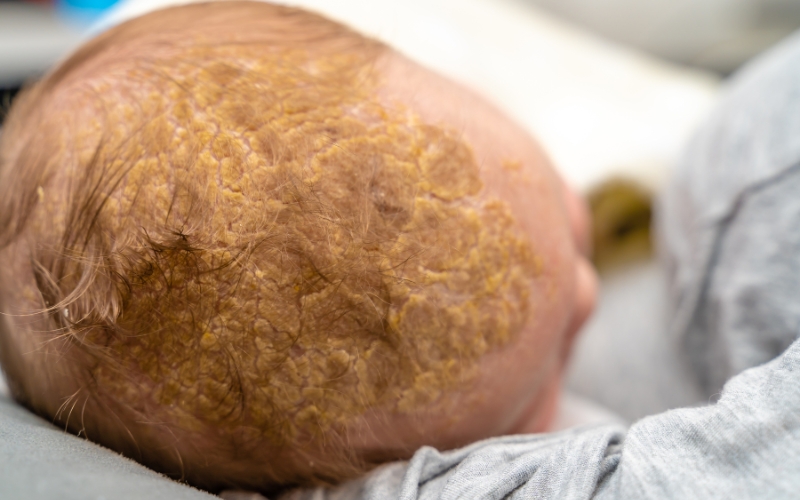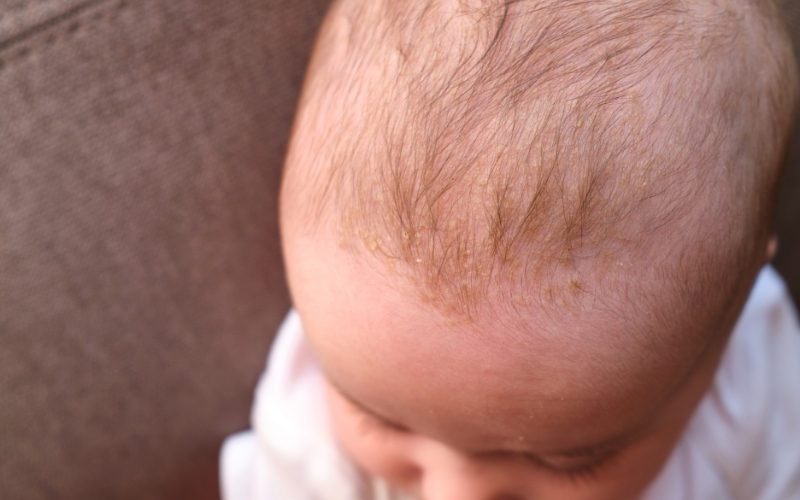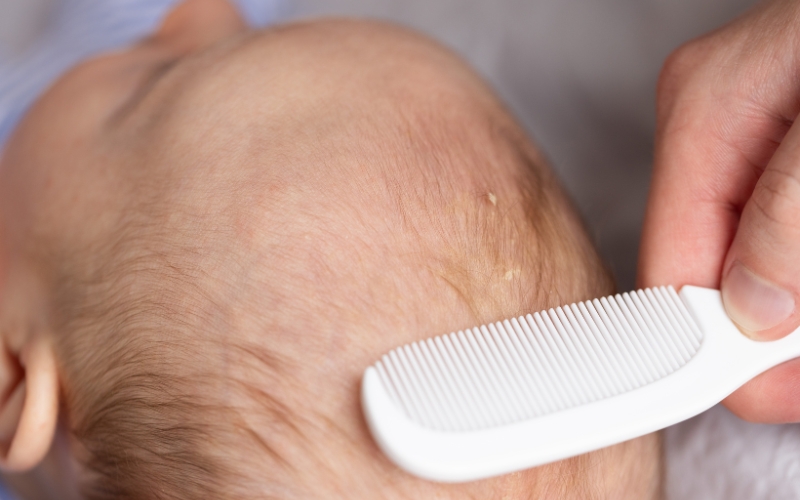Table of Contents
Prevent and Treat Cradle Cap

Cradle cap, or seborrheic dermatitis, is a common condition among infants that causes flaky, scaly patches on their scalp. While it is usually harmless and not painful for the baby, it can be unsightly and concerning for new parents. The good news is that there are many ways to prevent and treat cradle cap effectively. In this article, we’ll provide a comprehensive guide on how to prevent and treat cradle cap, introduce some of the best products available at [your store], and offer valuable insights into managing this condition.
Cradle cap, also known as infantile seborrheic dermatitis, is a common skin condition in babies, but there are effective ways to prevent and treat it. According to the Mayo Clinic’s guide on how to prevent cradle cap, maintaining proper scalp hygiene and using mild baby shampoos can help. For more information on recommended treatments and causes, check out their comprehensive cradle cap treatment guide, which provides evidence-backed strategies for addressing this condition.
What is Cradle Cap?

Cradle cap appears as greasy or dry patches on a baby’s scalp, often accompanied by redness and flakiness. It is caused by an overproduction of oil in the baby’s sebaceous glands, which traps dead skin cells and results in the crusty texture seen on the scalp. Though the exact cause isn’t fully understood, it is believed to be related to maternal hormones passed to the baby during pregnancy.
Most cases of cradle cap resolve on their own within a few months, but parents often want to speed up the process. With the right care and products, you can treat cradle cap gently and effectively.
Dealing with Cradle Cap can be challenging for new parents, but it’s important to remember that self-care is just as vital. If you’re struggling to balance your baby’s care with your own well-being, sleep deprivation may start to take its toll. To ensure you can provide the best care for your little one, make sure to address your own sleep needs too. Check out our guide on How to Deal With Sleep Deprivation After Baby for helpful strategies to manage sleep disruptions and stay rested, even during those sleepless nights.
Cradle Cap – Diagnosis and Treatment

Before diving into prevention methods, it’s essential to understand cradle cap – diagnosis and treatment. The diagnosis is straightforward, as most pediatricians can identify cradle cap just by examining the baby’s scalp. It doesn’t usually require any lab tests or medical interventions unless there is an infection or the condition spreads to other parts of the body.
As for treatment, many cases can be managed at home using gentle methods. These include soft brushing, washing the baby’s scalp with mild shampoo, and applying oils to loosen the scales. Our Gentle Baby Scalp Brush is perfect for daily care, helping to remove scales without irritating your baby’s delicate skin.
Steps for Treating Cradle Cap at Home:
- Brush the scales gently: Use a soft-bristled brush or a washcloth to loosen the scales.
- Wash with mild shampoo: Use a gentle baby shampoo to clean the scalp. Our Mild Baby Shampoo is specifically designed for babies with sensitive skin and helps reduce the buildup of oils and dead skin.
- Moisturize the scalp: Apply a baby-safe oil, like our Soothing Baby Oil, to soften and loosen the scales.
These basic steps are highly effective for most cases of cradle cap, but consistency is key. Regular scalp care will ensure that the condition improves over time.
12 Ways to Prevent and Treat Cradle Cap

- Keep the scalp clean: Regularly wash your baby’s scalp with a mild baby shampoo to prevent oil buildup. Washing every 2-3 days is generally enough.
- Brush daily: Gently brush your baby’s scalp daily to remove any loose flakes. The Gentle Baby Scalp Brush from our store is ideal for this purpose.
- Use baby-safe oil: Applying baby oil before washing can help soften and loosen the flakes. Try our Soothing Baby Oil for its gentle formula.
- Moisturize the skin: Use a baby-safe moisturizer to keep the skin hydrated. Dry skin can worsen cradle cap.
- Monitor for infection: If the skin becomes red, swollen, or oozes, consult a pediatrician for possible infection.
- Avoid harsh products: Refrain from using adult shampoos or oils, which can irritate your baby’s skin.
- Use a humidifier: Keeping a humidifier in your baby’s room can help prevent dry skin.
- Avoid over-washing: Washing too frequently can strip natural oils from the scalp, making cradle cap worse.
- Stick to a routine: Establish a consistent care routine to keep the condition from returning.
- Be gentle: Always be gentle when brushing or washing your baby’s scalp to avoid irritation.
- Consider professional advice: If home treatments aren’t working, talk to a pediatrician for medical-grade solutions.
- Use natural products: Look for products with natural, gentle ingredients to avoid harsh chemicals.
These 12 ways to prevent and treat cradle cap will help you take care of your baby’s scalp while minimizing discomfort.
While dealing with cradle cap can be a challenge for many parents, Managing Diaper Blowouts and Leaks is another common concern. Ensuring a proper diaper fit and selecting the right absorbent materials can help minimize messes. Consider using high-quality diapers that offer extra leak protection, especially during nighttime or extended periods. Additionally, diaper liners and protective covers can further enhance your baby’s comfort while preventing unnecessary leaks. For a better understanding of how to manage these challenges, explore our detailed guide on diapering essentials.
How to Treat Cradle Cap with the Right Products

One of the most effective methods of treating cradle cap is using the right products. At [your store], we offer a range of products specifically designed to gently treat and prevent cradle cap, ensuring your baby’s scalp stays healthy and flake-free.
- Gentle Baby Scalp Brush: A soft-bristled brush is an essential tool for removing flakes without harming your baby’s sensitive skin. Use this brush in a circular motion to loosen the scales before washing.
- Mild Baby Shampoo: Look for shampoos that are free from harsh chemicals and designed for sensitive skin. Our Mild Baby Shampoo is an excellent option for gentle cleansing.
- Soothing Baby Oil: Applying oil to the scalp can help soften scales and prevent dryness. The Soothing Baby Oil from our store is made with natural ingredients that nourish your baby’s skin.
These products, when used together, can provide a comprehensive solution for how to treat cradle cap effectively and gently.
When to See a Doctor

While cradle cap usually resolves on its own or with at-home treatments, there are some cases where medical attention is necessary. If your baby’s cradle cap doesn’t improve after several weeks of home care, or if you notice signs of infection, it’s time to consult a doctor.
Here are some signs that medical intervention might be needed:
- The affected area spreads to other parts of the body.
- The scalp becomes red, swollen, or starts oozing.
- Your baby seems uncomfortable or irritated by the condition.
In these cases, your pediatrician may prescribe a medicated shampoo or cream to treat the condition more aggressively. Cradle cap – diagnosis and treatment typically involves straightforward interventions that work quickly to resolve the issue.
While cradle cap is a common concern for many parents, it’s important to be aware of other conditions that can affect newborns, such as jaundice. Jaundice in newborns is a condition characterized by yellowing of the skin and eyes due to elevated bilirubin levels. Understanding the Jaundice in Newborns – Symptoms, Causes, and Treatment of jaundice can help you manage this condition and ensure your baby receives the proper care.
How to Treat Cradle Cap Long-Term

Preventing future outbreaks is just as important as treating existing ones. Once your baby’s cradle cap clears up, continuing a regular scalp care routine will help prevent its recurrence. Sticking to the tips mentioned earlier—such as regular brushing, using gentle products, and keeping the scalp clean—will ensure long-term results.
Using our 12 ways to prevent and treat cradle cap as part of your baby’s skincare routine will keep their scalp healthy. Products like the Gentle Baby Scalp Brush and Mild Baby Shampoo should be part of your regular regimen.
Conclusion
Managing cradle cap doesn’t have to be a stressful experience. By understanding the basics of cradle cap – diagnosis and treatment and following our 12 ways to prevent and treat cradle cap, you can ensure your baby’s scalp stays healthy and comfortable. Using the right products, such as our Gentle Baby Scalp Brush, Mild Baby Shampoo, and Soothing Baby Oil, will provide the best care for your little one’s skin.
Remember, cradle cap is a common condition that most babies experience at some point, but with patience and the right approach, it can be easily managed. Explore more of our baby care products at [your store] to ensure your baby gets the best treatment possible.
Traveling with a baby can be both exciting and challenging, but with the right preparation, it can be a smooth experience for everyone. From finding the best travel-friendly stroller to packing essential baby gear, having everything you need at your fingertips can make the journey easier. If you’re planning a trip soon, check out our detailed guide on How to travel with a baby, and the gear you need to ensure you’re fully prepared for any adventure with your little one.

